John Creasey was an English crime writer, also writing science fiction, romance and western novels, who wrote more than six hundred novels using twenty-eight different pseudonyms.
In the series of adventure novels by John Creasey, the Toff is the nickname of the Honourable Richard Rollison, an upper-class crime sleuth. Creasey published almost 60 Toff adventures, beginning with Introducing the Toff in 1938 and continuing through The Toff and the Crooked Copper, published in 1977, four years after the author's death.

Merlin's Furlong is a 1953 mystery detective novel by the British writer Gladys Mitchell. It is the twenty sixth entry in her long-running series featuring the psychoanalyst and amateur detective Mrs Bradley.
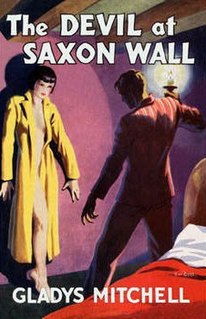
The Devil at Saxon Wall is a 1935 mystery detective novel by the British writer Gladys Mitchell. It is the sixth in her long-running series featuring the psychoanalyst and amateur detective Mrs Bradley. It was the first of a number of her books to feature the theme of witchcraft, the result of hearing a lecture about it from her friend Helen Simpson who she dedicated the novel to.
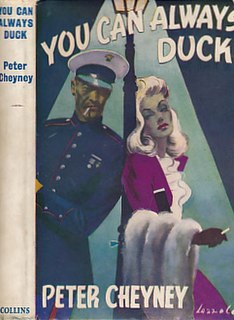
You Can Always Duck is a 1943 thriller novel by the British writer Peter Cheyney. It is the ninth in his series of novels featuring the FBI agent Lemmy Caution. The action takes place in wartime London where Caution is on the trail of a gang of black marketeers who have got mixed up in espionage. It was one of a number of films and novels of the period that made use of the booming black market for their setting.

The Widow's Cruise is a 1959 British detective novel by Cecil Day-Lewis, written under the pen name of Nicholas Blake. It is the thirteenth in a series of novels featuring the private detective Nigel Strangeways.

The Sea Mystery is a 1928 detective novel by Freeman Wills Crofts. It is the fourth in a series of novels featuring Inspector French of Scotland Yard. As with a number of his works Crofts creates a puzzling mystery which French is then able to solve using a Tide table and Bradshaw's Guide to the railways. The plot has some similarities with his debut novel The Cask (1920).

Checkmate to Murder is a 1944 detective novel by E.C.R. Lorac, the pen name of the British writer Edith Caroline Rivett. It was the twenty fifth in her long-running series featuring Chief Inspector MacDonald of Scotland Yard. Originally published by Collins Crime Club, it was reissued in 2020 by the British Library Publishing as part of a group of crime novels from the Golden Age of Detective Fiction.

Policemen in the Precinct is a 1949 detective story by E.C.R. Lorac, the pen name of the British writer Edith Caroline Rivett. It was the thirty third entry in her long-running series featuring Chief Inspector MacDonald of Scotland Yard. It was published in the United States by Doubleday using the alternative title And Then Put Out the Light.

Fire in the Thatch is a 1946 detective novel E.C.R. Lorac, the pen name of the British writer Edith Caroline Rivett. It is the twenty seventh in her long-running series featuring Chief Inspector MacDonald of Scotland Yard. Originally published by Collins Crime Club, it was reissued in 2018 by the British Library Publishing as part of a group of crime novels from the Golden Age of Detective Fiction.
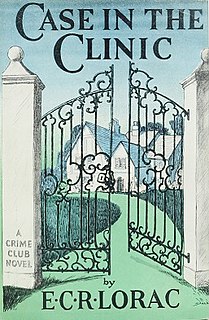
Case in the Clinic is a 1941 detective novel by E.C.R. Lorac, the pen name of the British writer Edith Caroline Rivett. It is the twentieth in her long-running series featuring Chief Inspector MacDonald of Scotland Yard, a Golden Age detective who relies on standard police procedure to solve his cases.

Murder by Matchlight is a 1945 detective novel by E.C.R. Lorac, the pen name of the British writer Edith Caroline Rivett. It was the twenty sixth novel of her long-running series featuring Chief Inspector MacDonald of Scotland Yard. Originally published by Collins Crime Club, it was reissued in 2018 by the British Library Publishing as part of a group of crime novels from the Golden Age of Detective Fiction.
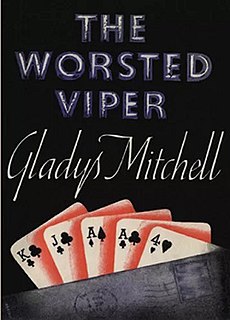
The Worsted Viper is a 1943 detective novel by the British writer Gladys Mitchell. It is the fifteenth in her long-running series featuring the psychoanalyst and amateur detective Mrs Bradley. Bradley was one of a number of investigators active during the Golden Age of Detective Fiction. Much of the novel takes place on the Norfolk Broads.

A Village Afraid is a 1950 detective novel by the British writer Cecil Street, writing under the pen name of Miles Burton. It was part of a lengthy series of books featuring the detective Desmond Merrion and Inspector Arnold of Scotland Yard.

Dead on the Track is a 1943 detective novel by John Rhode, the pen name of the British writer Cecil Street. It is the thirty seventh in his long-running series of novels featuring Lancelot Priestley, a Golden Age armchair detective. Like a number of mystery novels of the era, it has a railway setting. In theme and plot it is very similar to the author's earlier 1931 work Tragedy on the Line. It is the first entry in the series since Hendon's First Case (1935) in which Priestley's old associate Hanslet is the lead investigator. The other recurring police officer in the series Inspector Jimmy Waghorn is now working with military intelligence.
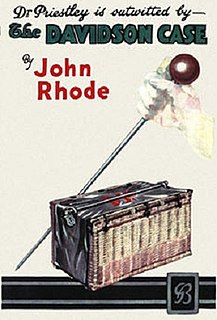
The Davidson Case is a 1929 detective novel by John Rhode, the pen name of the British writer Cecil Street. It was the seventh appearance of the armchair detective Lancelot Priestley, who featured in a long-running series of novels during the Golden Age of Detective Fiction.

Old Mrs. Fitzgerald is a 1939 detective novel by the British writer Anne Hocking. It was the first novel in her long-running series featuring Chief Inspector William Austen of Scotland Yard. Austen was one of a large number of investigators operating during the Golden Age of Detective Fiction.
Salute the Toff is a 1941 crime thriller novel by the British writer John Creasey. It is the sixth in his long-running featuring the gentleman amateur detective The Toff.

Beware of the Trains is a collection of detective short stories by the British writer Edmund Crispin published in 1953. It contains sixteen stories including Beware of the Trains which gave its title to the collection. They all feature Crispin's amateur detective and Oxford professor Gervase Fen, an eccentric with a genius for solving complex cases. A number also featured Detective Inspector Humbleby of Scotland Yard who also appears in two of the novels in the Fen series. Apart from one they had all previously appeared in the Evening Standard newspaper. It was the last work featuring Fen for many years, until Crispin returned to the character for the 1977 novel The Glimpses of the Moon.
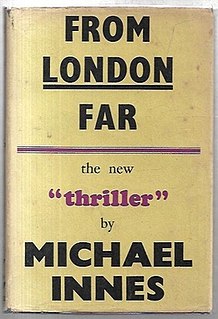
From London Far is a 1946 mystery thriller novel by the British writer Michael Innes. It is a standalone novel from the author who was best known for his series featuring the Golden Age detective John Appleby. Like much of Innes work it contains elements of farcical humour. It was published the same year in the United States by Dodd, Mead under the alternative title The Unsuspected Chasm.

















